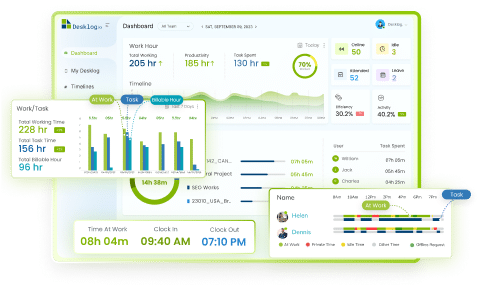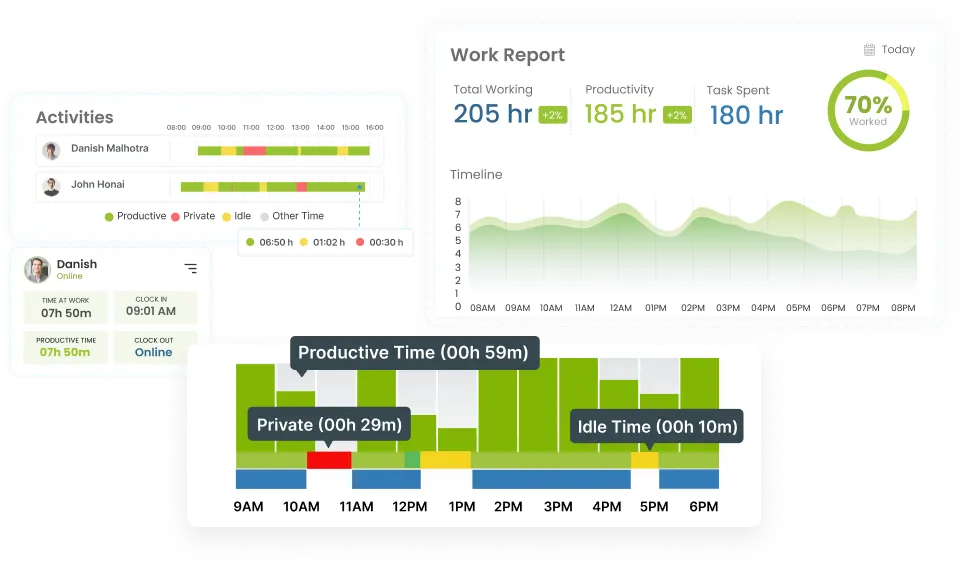
Remote Employee Management: Insights From Industry Experts in 2025
Do you yearn for the freedom to work from wherever you like, be it your cozy home or a sandy beach? Well, you’re not alone! The popularity of remote work has shot through the roof recently and does not really seem to be fading away.
Over 60% of the workforce is now working remotely, according to statistics from 2023, which show a sudden spike in the amount of remote workers. With this rapid shift towards remote work, remote employee management has become a critical challenge for businesses of all sizes.
Come along as we look into “Remote Employee Management: Insights from Industry Experts in 2023”. Don’t forget your jetpacks, because remote work will now be done on Mars 🛰️
Welcome to the future of remote work!
But, What Is Remote Employee Management?
Remote employee management, also known as remote workforce management involves efficiently overseeing and directing a team of remote workers. This includes a combination of communication methods, procedures, and technological tools that are tailored to enhance the productivity of a remote workforce.
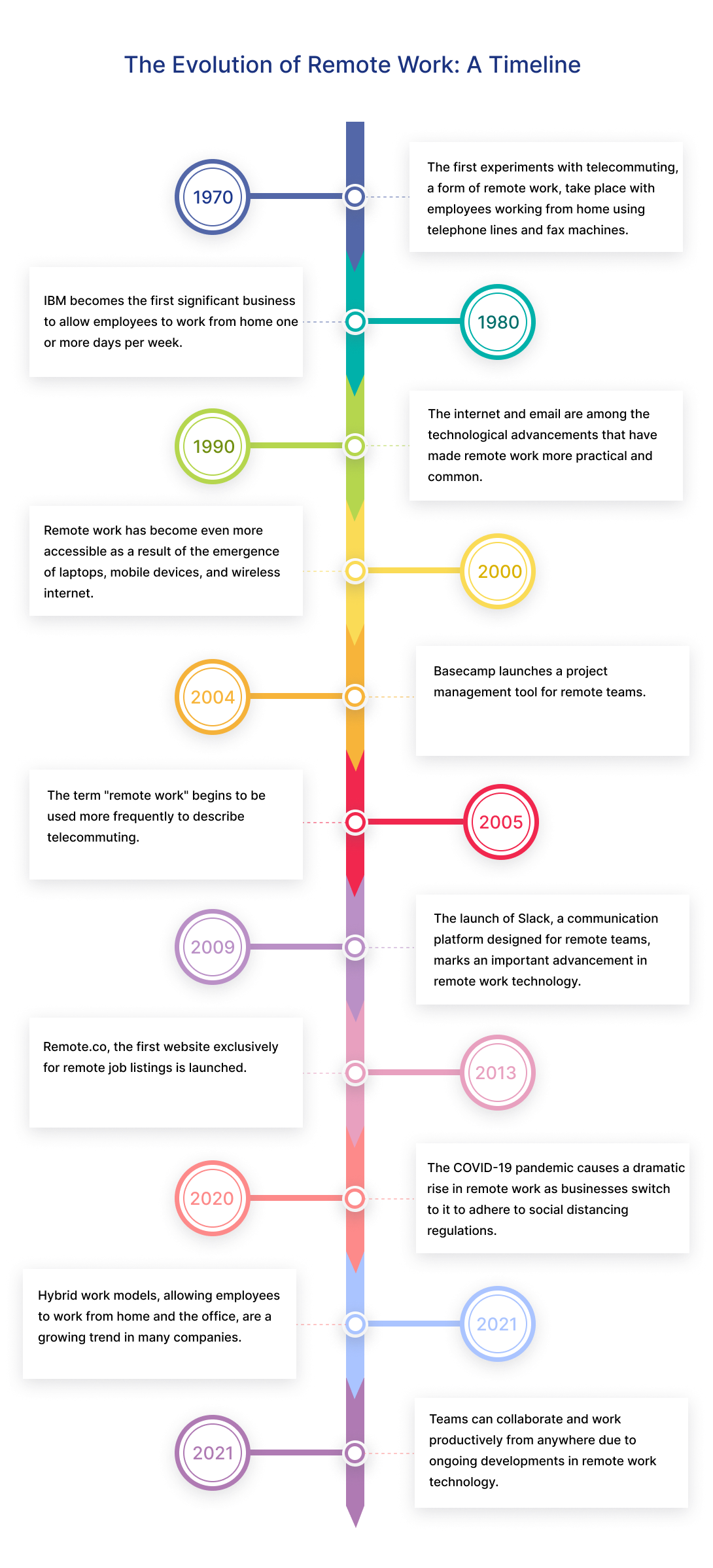
Present Landscape of Remote Work in 2023
Remote work has become the norm for many businesses as the world struggles to deal with the effects of the pandemic. And, it has also given rise to many thoughtful discussions regarding the future of employee productivity.
More and more businesses are adopting remote work arrangements as a feasible alternative to traditional office-based work as a result of ongoing technological advancements and the global pandemic that speeded up the transformation towards remote work. In 2023, the state of remote employee management has undergone significant changes, and industry leaders have had to adapt to the new work culture.

Jeff Bezos

CEO of Amazon, believes remote work is here to stay. He stated in a recent interview that remote work had allowed him and his team to hire the best talent available worldwide and that productivity had increased significantly. But he also admits that managing remote workers can be difficult & also added that, “to make sure that our remote employees get the support and direction they need to succeed, we had to change our management approach”.
Similar tools and technologies are needed for hybrid work, which combines in-person and remote work, to ensure effective teamwork and communication. For instance, time tracking software for hybrid work can help to elevate employee productivity like never before. To ensure a seamless shift between remote and in-person work, organisations need to implement new technologies and procedures. At the same time, they also need to develop a hybrid workplace culture that values both remote and in-person workers equally.
According to the Garner Report, a hybrid work model is already used by 66% of organisations, and 30% say they intend to adopt one. Therefore, it is essential to update your policies to comply with this standard.

Tim Cook

CEO of Apple, believes that the future of employee productivity is hybrid work. He said, “While remote work has its benefits, there is still value in having face-to-face interactions. We believe a hybrid work model combining in-person and remote work will maximize employee productivity.”
However, working from home isn’t always rainbows and butterflies. Sometimes, your wifi takes a day off, or your cat sits on your keyboard during an important meeting. And don’t even get me started on the struggle of finding a good background for your Zoom calls that doesn’t make you look like you’re sitting in a dungeon.
Also, maintaining a healthy work-life balance for remote employees presents a great challenge for businesses. Because, remote workers frequently struggle to switch off from work and find time for personal activities resulting in toxic productivity. Due to this, many businesses now have policies in place encouraging remote employees to take regular breaks and set up distinct boundaries between work and personal time.

Ratan Tata

Chairman of Tata Group, believes time management is critical for remote employees. He said, “Remote work can blur the lines between work and personal life, and employees need to manage their time effectively to prevent burnout.” He recommends setting boundaries between work and personal time and creating a schedule to help manage tasks.
As the remote work scene keeps shifting, it’s crucial for companies and employees to get their act together and roll with the punches when it comes to remote employee management. They need to think outside the box and be proactive in their approach to keep up with trends. After all, when the going gets tough, the tough get going! 😎
While remote work has challenges like effectively managing time, it has also opened up new opportunities for companies to hire the best talent worldwide. As Jeff Bezos said, “The future of work is not about where you work, but what you can accomplish.”
Want to try our Time Tracking Software?
Try Desklog for free!

Current Trends of Remote Work
The current trend of remote work is sweeping the globe and fulfilling your work-from-home dreams. So, let’s look at some of the current trends in the realm of remote work;
Hybrid Work Models

Without a shadow of doubt, it can be said that the hybrid work model is the trendiest trend of remote work. At present, many businesses are looking for ways to reduce costs while keeping their workforce due to the ongoing layoffs as reported by Harvard Business Review. By implementing a hybrid work model, businesses can save money on overhead expenses like office space and utilities while keeping their current workforce by also enhancing employee productivity during recession.

Anand Mahindra

In a tweet posted on June 16, 2020, Anand Mahindra, the Chairman of the Mahindra Group, expressed his support for remote work arrangements. He asserted that the business has found that allowing employees to work remotely has increased productivity and is likely to keep using a flexible work model.
In a follow-up tweet posted on August 10, 2020, Mahindra acknowledged that working remotely has drawbacks, including issues with team collaboration and a feeling of isolation. But he added that he thinks businesses should welcome the difficulties and seize the chance to reimagine their workplace environments.
Digital Nomadism

Another trend in remote work is the growth of digital nomadism. People who work from home while travelling the globe are known as digital nomads. These modern-day adventurers are packing up their laptops and hitting the road, exploring the world while still advancing their careers. Younger workers who value experiences and flexibility over stability and routine are drawn to this way of life. But, with many productivity tools on the table, there’s nothing to worry about. Right?

Elon Musk

In a tweet in May 2020, Musk wrote, “Don’t have to be at the company location physically, which is a huge improvement. Please consider moving to Starbase or the greater Brownsville/South Padre area in Texas & encourage friends to do so! SpaceX’s hiring needs for engineers, technicians, builders & essential support personnel of all kinds are growing rapidly.”
Emphasis on Work-Life Balance

Remote work has also placed a greater emphasis on work-life balance. With the boundaries between work and home blurred, many workers struggle to find a healthy balance between their personal and professional lives. But, productivity rules like 1-3-5 are sailing high on the rescue boat to help you from drowning.

N.R. Narayana Murthy

In a recent interview, N.R. Narayana Murthy emphasized the need for work-life balance and stated that the pandemic has made people realize the importance of balancing work and personal life. He believes that remote work is here to stay, but balancing productivity and personal well-being is important.
Increased Dependence on Technology

A greater reliance on technology is another effect of remote work. With workers spread out across the globe, digital tools have become the glue that holds teams together. A few instances of the innovation that has become crucial to remote work include video conferencing, project management software, and instant messaging.

Mark Zuckerberg

In a Facebook post, Zuckerberg stated that he predicts that within the next five to ten years, half of Facebook’s staff will be working remotely.
In an interview with The Verge in July 2020, Zuckerberg said, “I think we’re going to have the technology in the next five to ten years to be able to feel really present with people remotely. And that’s going to be amazing.”
Focus on Results

No longer do employees have to punch a clock or be tethered to a cubicle to prove their worth – instead, they can focus on achieving their goals and delivering top-notch work from anywhere in the world. Nevertheless, remote work has compelled businesses to evaluate staff members on the outcomes they produce rather than the number of hours they put in as per a recent report.

Jeff Bezos

In a recent letter to shareholders in 2018, Jeff Bezos discussed the benefits of the “two-pizza team” concept: teams should be small enough to be fed with two pizzas. Since remote work permits more freedom and control in how teams collaborate, this idea is closely related to it. Bezos wrote, “We try to create teams no larger than can be fed by two pizzas. When a team gets too large, we find it difficult to innovate and accomplish anything. We also believe that remote teams are not a disadvantage, and often a distinct advantage.”
Benefits and Challenges of Remote Work
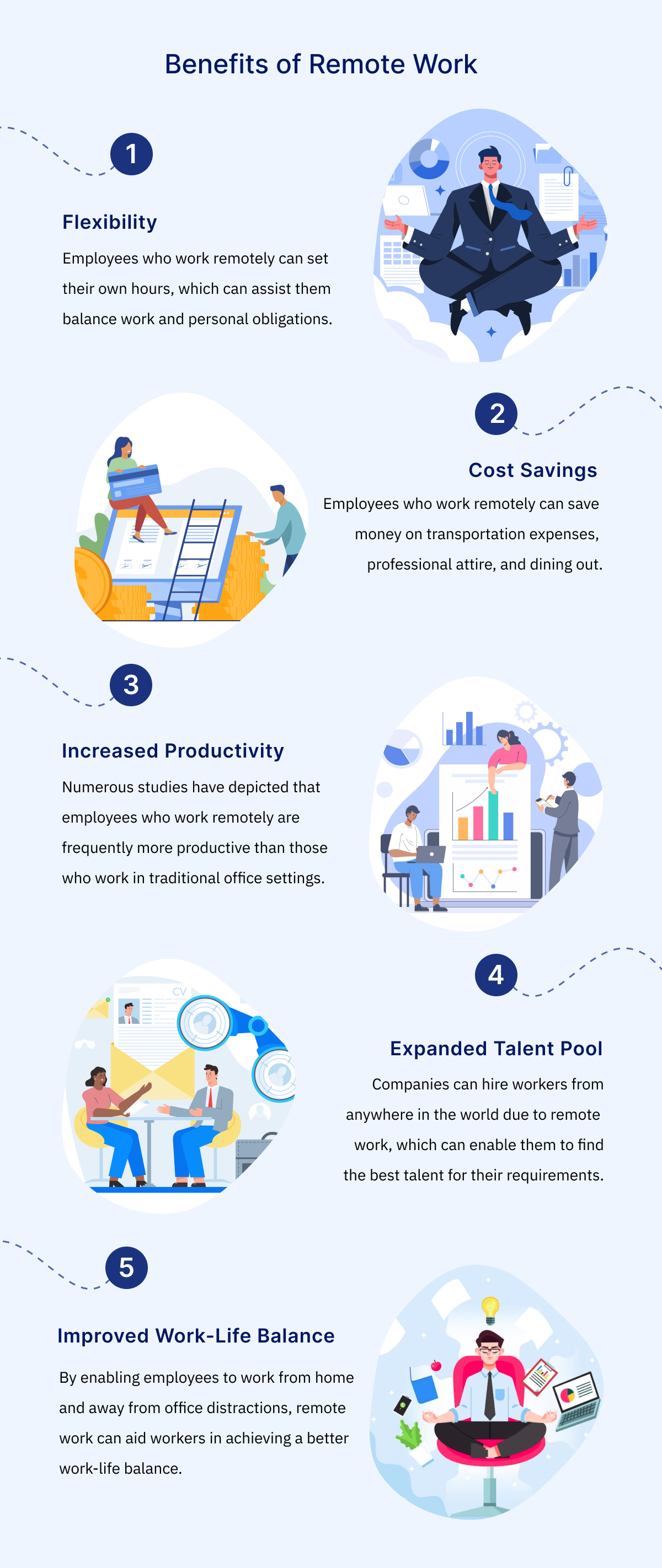
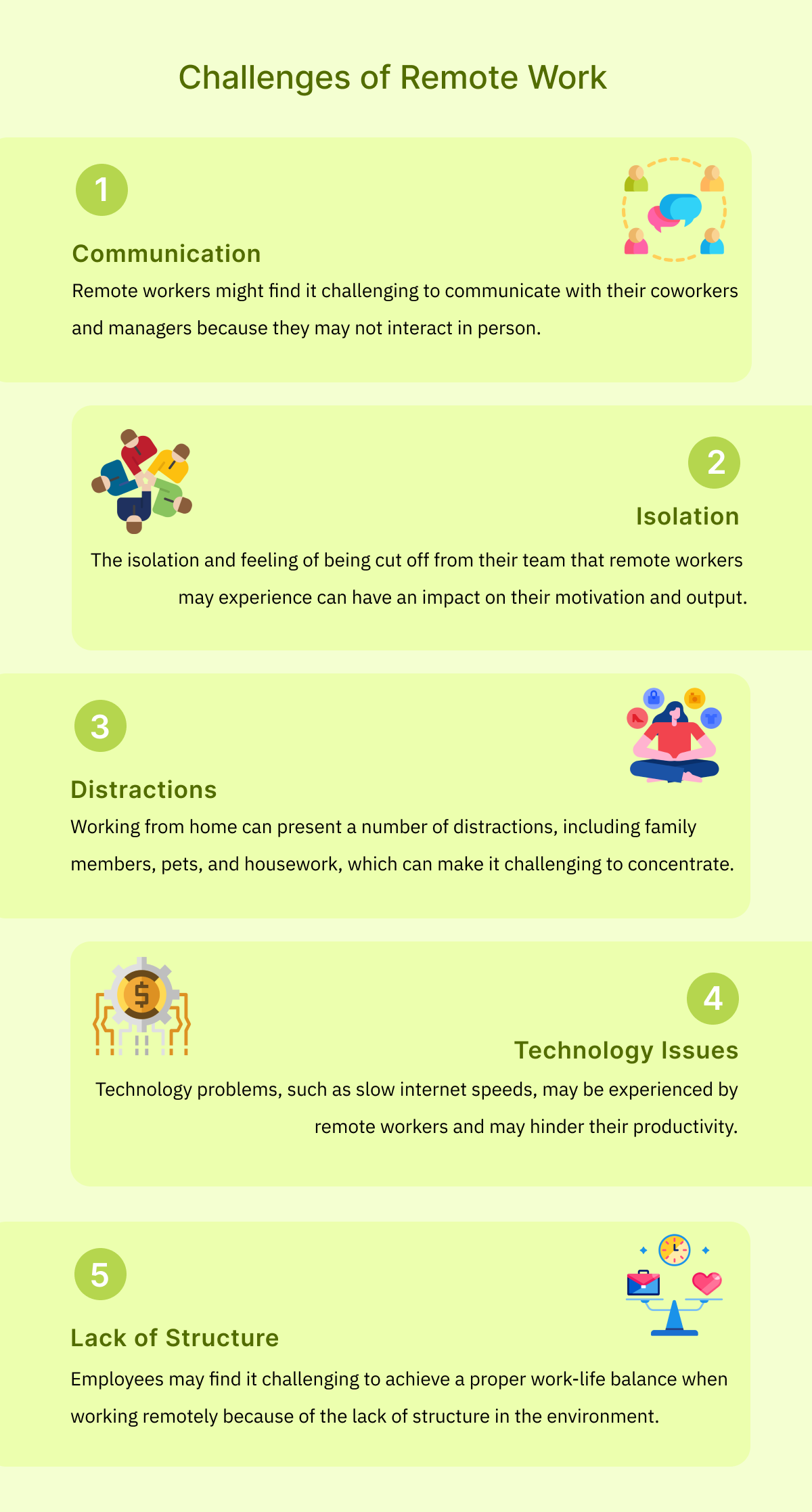
10 Best Practices for Managing Remote Employees
Despite the many benefits of hybrid and remote models, some managers might find it more challenging to manage their employees when they are sited elsewhere. They may even find themselves Googling “How to manage remote employees without going crazy” for a little extra guidance! Just Kidding! 😉
Tracking productivity and results, as well as time spent on tasks, while encouraging mutual respect and teamwork among remote workers can be difficult for managers to do without the right tools, such as time tracking software. Some of the top strategies for handling remote workers are listed below:
Establish clear channels and procedures for communication. This includes establishing guidelines for response times and using the proper communication tools.
It’s critical to prioritise the mental health and wellbeing of employees because remote work can be isolating. Provide resources for mental health, and nudge staff to prioritise self-care and take breaks.
Set clear metrics for employee productivity and establish a system for tracking progress towards these goals.
Encourage collaboration and team building among remote workers. This can be done through virtual team building activities, regular check-ins, and creating opportunities for cross-functional projects.
Make sure that remote workers are performing their jobs effectively by investing in time tracking softwares. This may involve receiving ongoing assistance from peers and managers as well as training on new software or tools.
All employees are not created equal. As a matter of fact, it is always crucial to ask your workers what makes them productive.
Checking in frequently can make remote workers feel supported and connected. Encourage your managers to arrange regular one-on-one meetings for your remote workers.
Consider meeting times and deadlines if your remote team is dispersed across multiple time zones. Be flexible when required and work out a time that works for everyone.
Create a clear remote work policy as it can help to make sure that everyone is mindful of what’s required of them and that they are all on the same page.
Employees can concentrate on results rather than hours worked when they work remotely. Turn attention away from sitting at a desk and towards performance and productivity.
Future of Remote Work Trends & Their Impact on Remote Employee Management
The next few years are likely to see several trends in remote work, which could challenge managers to rethink how they manage their remote teams. Let’s take a closer look at some of the emerging trends that are likely to impact remote work in the future;
Digital Transformation

The integration of digital technologies across all aspects of company operations is referred to as “digital transformation.” It’s like a turbocharger for your business engine. As per a report by Forbes, digital transformation can improve efficiency, reduce costs, and enhance the employee experience. It also calls for learning new abilities and knowledge, which some workers might find difficult.
Recommendation :To assist them in acquiring the skills and knowledge required to adapt to the digital transformation, managers should invest in employee training and development programmes thereby effectively managing remote employee management.
Flexible Work Arrangements

In recent years, flexible work schedules have gained popularity, and the pandemic has amplified this trend. Employees now have the opportunity to have their cake and eat it too – they can enjoy a fulfilling work life while also having enough time to spend with their loved ones. However, they also pose difficulties for managing remote workers, such as coordinating workloads and scheduling.
Recommendation :To make sure that all employees, whether they are based remotely or in the office, are on the same page, managers should set up clear communication channels and schedules. They should also give remote workers the equipment and materials they need to do their jobs well and quickly, such as employee productivity tracking software or collaboration tools.
Endnote
It’s crucial to stay informed and adaptable as we continue to navigate the changing landscape of remote work, taking into account best practises and lessons discovered from both experts and peers. Employers and employees can both benefit from the productive and satisfying remote work environment that can be created by organisations. Come rain or shine, remote work is here to stay for sure. And the best part? Whether you’re a night owl or an early bird, you can work at your own pace and create a work-life balance that suits you to a tee.
